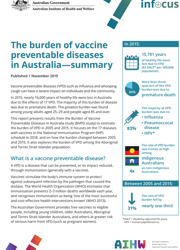Burden of vaccine preventable diseases
The Burden of Vaccine Preventable Diseases in Australia study (BVPD study) was undertaken to further investigate the burden due to vaccine preventable diseases (VPD) in Australia. The analysis responds to the following broad questions:
- What is the current burden due to VPD in Australia and how has it changed over time?
- How does the burden vary by sex, across age groups, for Aboriginal and Torres Strait Islander people and by states and territories?
How do you measure burden of disease?
Burden of disease uses a summary measure called a 'disability-adjusted life year' (DALY). This measure combines the fatal and non-fatal burden of disease to describe the overall burden. One DALY represents 1 year of healthy life lost, either through premature death or from living with illness or injury.
For more information on the methods used, refer to 'The burden of vaccine preventable diseases in Australia' report.
Which vaccine preventable diseases caused the most burden?
As a group, the 17 VPD were responsible for almost 16,000 DALY in 2015. Premature death (fatal burden) accounted for 80% of this burden.
Influenza contributed more than one-third of the total VPD burden (5,674 DALY, 36%) in 2015, followed by pneumococcal disease (3,793 DALY, 24%) and human papillomavirus (HPV) (3,710 DALY, 24%).

Rate of burden varied by age
In 2015, the rate of burden due to VPD was highest among infants and those aged 85 and older.
Among those aged 1–74, young adults aged 25–29 had the highest rate of burden in 2015. The high burden among young adults is because of potential long-term outcomes—such as cervical cancer after infection with the HPV.

What has changed over time?
When comparing results from the 2 reference years (2015 and 2005), it is important to note that differences in the burden may have been affected by both the cyclic epidemics of many diseases (for example, influenza and whooping cough) and changes in disease surveillance and reporting practices.
The overall burden of VPD decreased between 2005 and 2015. The number of DALY decreased by 13% overall, and the age-standardised rate by 31%.
Age-specific burden rates were similar in 2005 and 2015 for those aged 5–14 and 25–39, and increased slightly for those aged 40–64. However, compared with the 2005 rates, 2015 rates were considerably lower for infants, young children and young adults aged 15–24, and considerably higher for those aged 65 and over.



